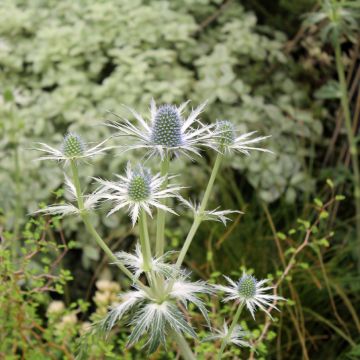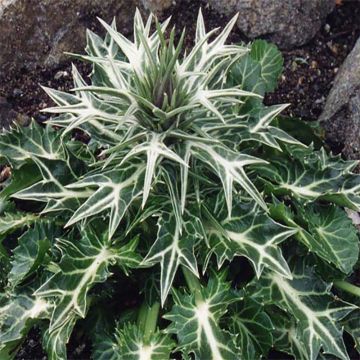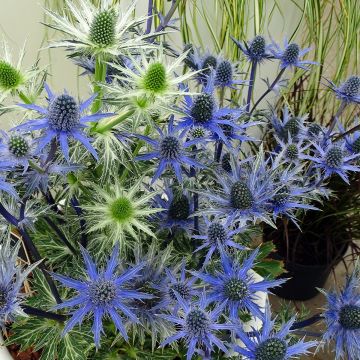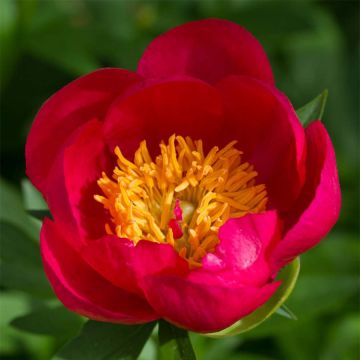

Eryngium planum


Eryngium planum
Eryngium planum
Eryngium planum
Flat Sea Holly, Blue Eryngo
This item cannot be shipped to the selected country
Delivery charge from €5.90
Delivery charge from €5.90
More information
Schedule delivery date,
and select date in basket
This plant carries a 12 months recovery warranty
More information
We guarantee the quality of our plants for a full growing cycle, and will replace at our expense any plant that fails to recover under normal climatic and planting conditions.
From €5.90 for pickup delivery and €6.90 for home delivery
Express home delivery from €8.90.
From €5.90 for pickup delivery and €6.90 for home delivery
Express home delivery from €8.90.

Does this plant fit my garden?
Set up your Plantfit profile →
Description
Eryngium planum is a picturesque blue thistle, which is both charming and prickly! This perennial species offers an abundance of flowers resembling small azure pom-poms on branched steel-blue stems in summer. It is a sculptural and highly decorative plant that will be appreciated in slightly wild areas of the garden or in a rockery. Its steel-blue colour is even more intense when planted in full sun, in poor, rocky, and fairly dry soil. Its flowers are also beautiful in fresh or dried bouquets.
Eryngium planum (synonym Eryngium armatum), also known as blue eryngo, is a plant in the Apiaceae family, just like celery and carrot. It is an herbaceous perennial plant native to the mountains of central Europe. In nature, it is found in dry and sunny places, in well-drained gravelly or sandy soil.
With an upright and bushy habit, it quickly reaches about 80cm (32in) in height and 50cm (20in) in width. Its root develops a rosette of basal leaves with petioles. They are ovate with a heart-shaped base, thick, toothed, dark green, shiny, and evergreen in winter. Tall, dark blue-grey, branched stems adorned with a few small leaf spines without petioles rise from the basal rosettes. The flowering occurs in June-July, at the tips of these branches. It takes the form of ovoid inflorescences, 2cm (1in) in diameter, composed of a multitude of tiny azure-blue flowers, surrounded at the base by thin toothed bracts of the same blue colour with metallic reflections. This flowering attracts many pollinating insects. Eryngium planum easily self-seeds in light and well-drained soil.
It does not live very long (especially in fertile and moist soil), but it easily self-seeds where it pleases. It is superb in the company of Lychnis coronaria, grasses (Stipa, Carex comans, Muhlenbergia), catmints, and shrubby salvias. It pairs very well with roses, primroses, cornflowers, and cosmos, or with tall mulleins in dry gardens. A plant to admire in a countryside border, with its fascinating colour and somewhat futuristic design.
Report an error about the product description
Eryngium planum in pictures


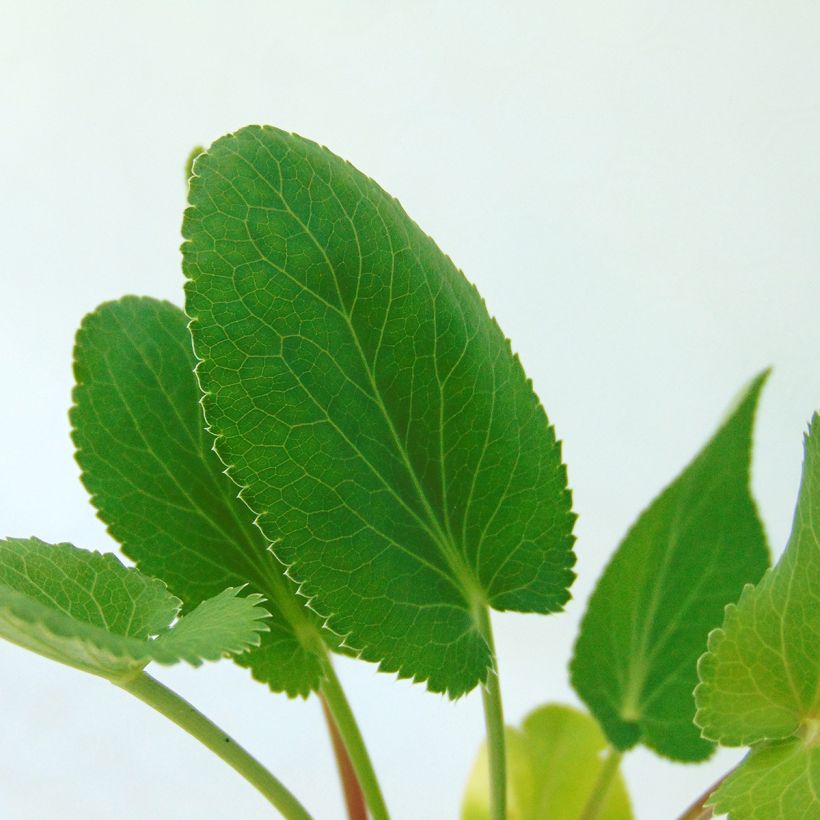

Flowering
Foliage
Plant habit
Botanical data
Eryngium
planum
Apiaceae
Flat Sea Holly, Blue Eryngo
Central Europe
Other Eryngium - Eryngo
Planting and care
In nature, Eryngium planum is almost always found in uncultivated places, on dry and stony embankments, flooded with sun. It will even tolerate limestone. In these conditions, it rarely exceeds 60cm (24in) in height and does not collapse, unlike in fertile and moist gardens. Similarly, the blue colouration of its floral stems and flowers will be accentuated in poor and dry soils. It easily self-seeds in light soil. Plant it in well-draining soil, possibly enriched with stones and gravel, to help it withstand humid and cold winters. It is very hardy, but its roots can rot in damp and frozen soil.
Planting period
Intended location
Care
-
, onOrder confirmed
Reply from on Promesse de fleurs
Mediterranean perennials
Haven't found what you were looking for?
Hardiness is the lowest winter temperature a plant can endure without suffering serious damage or even dying. However, hardiness is affected by location (a sheltered area, such as a patio), protection (winter cover) and soil type (hardiness is improved by well-drained soil).

Photo Sharing Terms & Conditions
In order to encourage gardeners to interact and share their experiences, Promesse de fleurs offers various media enabling content to be uploaded onto its Site - in particular via the ‘Photo sharing’ module.
The User agrees to refrain from:
- Posting any content that is illegal, prejudicial, insulting, racist, inciteful to hatred, revisionist, contrary to public decency, that infringes on privacy or on the privacy rights of third parties, in particular the publicity rights of persons and goods, intellectual property rights, or the right to privacy.
- Submitting content on behalf of a third party;
- Impersonate the identity of a third party and/or publish any personal information about a third party;
In general, the User undertakes to refrain from any unethical behaviour.
All Content (in particular text, comments, files, images, photos, videos, creative works, etc.), which may be subject to property or intellectual property rights, image or other private rights, shall remain the property of the User, subject to the limited rights granted by the terms of the licence granted by Promesse de fleurs as stated below. Users are at liberty to publish or not to publish such Content on the Site, notably via the ‘Photo Sharing’ facility, and accept that this Content shall be made public and freely accessible, notably on the Internet.
Users further acknowledge, undertake to have ,and guarantee that they hold all necessary rights and permissions to publish such material on the Site, in particular with regard to the legislation in force pertaining to any privacy, property, intellectual property, image, or contractual rights, or rights of any other nature. By publishing such Content on the Site, Users acknowledge accepting full liability as publishers of the Content within the meaning of the law, and grant Promesse de fleurs, free of charge, an inclusive, worldwide licence for the said Content for the entire duration of its publication, including all reproduction, representation, up/downloading, displaying, performing, transmission, and storage rights.
Users also grant permission for their name to be linked to the Content and accept that this link may not always be made available.
By engaging in posting material, Users consent to their Content becoming automatically accessible on the Internet, in particular on other sites and/or blogs and/or web pages of the Promesse de fleurs site, including in particular social pages and the Promesse de fleurs catalogue.
Users may secure the removal of entrusted content free of charge by issuing a simple request via our contact form.
The flowering period indicated on our website applies to countries and regions located in USDA zone 8 (France, the United Kingdom, Ireland, the Netherlands, etc.)
It will vary according to where you live:
- In zones 9 to 10 (Italy, Spain, Greece, etc.), flowering will occur about 2 to 4 weeks earlier.
- In zones 6 to 7 (Germany, Poland, Slovenia, and lower mountainous regions), flowering will be delayed by 2 to 3 weeks.
- In zone 5 (Central Europe, Scandinavia), blooming will be delayed by 3 to 5 weeks.
In temperate climates, pruning of spring-flowering shrubs (forsythia, spireas, etc.) should be done just after flowering.
Pruning of summer-flowering shrubs (Indian Lilac, Perovskia, etc.) can be done in winter or spring.
In cold regions as well as with frost-sensitive plants, avoid pruning too early when severe frosts may still occur.
The planting period indicated on our website applies to countries and regions located in USDA zone 8 (France, United Kingdom, Ireland, Netherlands).
It will vary according to where you live:
- In Mediterranean zones (Marseille, Madrid, Milan, etc.), autumn and winter are the best planting periods.
- In continental zones (Strasbourg, Munich, Vienna, etc.), delay planting by 2 to 3 weeks in spring and bring it forward by 2 to 4 weeks in autumn.
- In mountainous regions (the Alps, Pyrenees, Carpathians, etc.), it is best to plant in late spring (May-June) or late summer (August-September).
The harvesting period indicated on our website applies to countries and regions in USDA zone 8 (France, England, Ireland, the Netherlands).
In colder areas (Scandinavia, Poland, Austria...) fruit and vegetable harvests are likely to be delayed by 3-4 weeks.
In warmer areas (Italy, Spain, Greece, etc.), harvesting will probably take place earlier, depending on weather conditions.
The sowing periods indicated on our website apply to countries and regions within USDA Zone 8 (France, UK, Ireland, Netherlands).
In colder areas (Scandinavia, Poland, Austria...), delay any outdoor sowing by 3-4 weeks, or sow under glass.
In warmer climes (Italy, Spain, Greece, etc.), bring outdoor sowing forward by a few weeks.

































